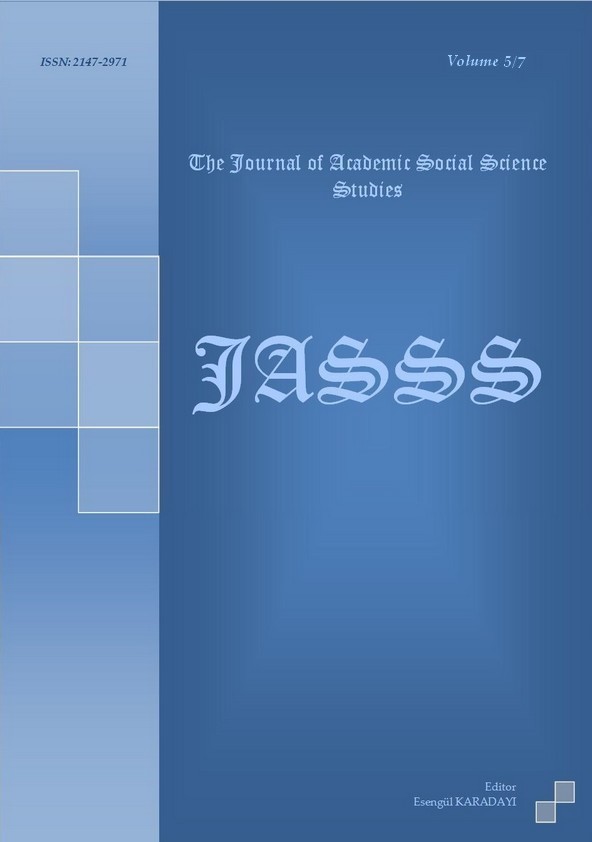Author :
Abstract
Bu çalışma eğitim fakültesi biyoloji, fizik ve kimya öğretmenliği bölümüne devam eden öğretmen adaylarının biyoçeşitlik okuryazarlıklarını cinsiyet, çevre eğitimi konusundaki bilgi kaynağı, çevre eğitimi dersi alma ve bölümlerine göre incelemek amacıyla yapılmıştır. Çalışmaya dördüncü ve beşinci sınıfa devam eden öğrenciler (N= 228) dâhil edilmiştir. Tarama modeliyle yapılan çalışmada üçlü likert tipi ölçek kullanılmıştır. 25 maddeden oluşan ölçek üç faktöre sahiptir. Ölçeğin 11 maddesi biyoçeşitliği tehdit unsurlarını (?:.72), 8 maddesi biyoçeşitlik kavramı (?:.76) ve 6 maddesi biyoçeşitliğin önemini (?: .81) belirlemeye yönelik olarak hazırlanmıştır. ‘Katılıyorum’, ‘katılmıyorum’ ve ‘karasızım’ seçeneklerinden oluşmaktadır. Çalışma neticesinde, cinsiyete göre biyoçeşitliği tehdit unsurları alt boyutunda istatistiksel yönde anlamlı farkın bayanların lehinde çıktığı ve bununla birlikte ölçeğin bütün alt boyutlarda bayanların ortalama puanlarının erkeklerden daha yüksek olduğu tespit edilmiştir. Bilgi kaynağı olarak anlamlı farkın basılı kaynaklar lehinde olduğu ve elektronik kaynakların bilgi kaynağı olarak tercih edilmediği tespit edilmiştir. İstatistiksel olarak anlamlı farkın basılı kaynaklar lehinde çıktığı görülmüştür. Çevre eğitimi konusunda ders alıp almama durumlarına göre anlamlı farkın çevre eğitimi dersi alanlar lehinde bir sonuç elde edildiği görülmüştür. Bölümlere göre yapılan analizler neticesinde biyoçeşitliği tehdit unsurları ve biyoçeşitliğin önemini konusundaki alt boyutlarda biyoloji öğrencilerinin lehinde istatistiksel olarak anlamlı bir fakın tespit edildiği; ancak biyoçeşitlik kavramı konusundaki alt boyutunda kimya öğrencilerinin lehinde anlamlı bir farkın tespit edildiği görülmüştür.
Keywords
Abstract
The aim of this study was to investigation of department of biology, physics and chemistry pre-service teachers’ bio
Keywords
- ABDULLAH, S. S. I. S. & HALIM, L. (2010). Development of instrument measuring the level of teachers' Pedagogical Content Knowledge (PCK) in environmental education, Procedia Social and Behavioral Sciences, 9, 174–178.
- BARRAZA, L. & CUARÓN, D. A. (2004). How values in education affect children's environmental knowledge, Journal of Biological Education, 39:1, 18-23.
- BLUM, N. (2008). Environmental education in Costa Rica: Building a framework for sustainable development,?, International Journal of Educational Development, 28, 348–358. www.sciencedirect.com 08.09.2012
- Convention on Biological Diversity (CBD) (2009). Secretariat of the Convention on Biological Diversity Sustaining, Life on Earth. 06.09.2012
- DAVĠDSON, D. & FREUDENBERG ,W. (1996). Gender and environmental risk concerns: a review of available research. Environment and Behavior, 28, 302–339.
- DREYFUS, A., WALS, J.E.A. and WEELĠE, D. (1999).Biodiversity as a Postmodern Theme for Environmental Education, Canadian Journal of Environmental Education, 4, 155
- DOR-HAĠM, S., AMĠR, R. & DODĠCK, J. (2011).What do Israeli high school students understand about biodiversity? An evaluation of the high school biology programme, „Nature in a World of Change‟, Journal of Biological Education, 45:4, 198-207
- EKĠCĠ, G. (2005). Lise öğrencilerinin çevre eğitimine yönelik tutumlarının incelenmesi. Eğitim AraĢtırmaları. 18, 71-83
- GAYFORD, G. (2000): Biodiversity Education: A teacher's perspective, Environmental Education Research, 6:4, 347-361
- GÜRBÜZ, H. ÇAKMAK, M. and DERMAN, M. (2013). Biyoloji Öğretmen Adaylarının Sürdürülebilir Çevreye Yönelik Tutumları, Türk Bilimsel Derlemeler Dergisi 6 (1): 144-149. www.nobel.gen.tr
- GÜRBÜZ, H. DERMAN, M. and ÇAKMAK, M. (2012). BiyoçeĢitlik Okuryazarlığı Ölçeği: GeliĢtirme, Geçerlik ve Güvenirliği, X.Ulusal Fen Bilimleri ve Matematik Eğitimi Kongresi, pp. 43, Niğde
- KAHYAOĞLU, M. and ÖZGEN, N. (2011). Kırsal kesimde yaĢayan ilköğretim öğrencilerinin çevre yönelik tutumlarının çeĢitli değiĢkenler açısından değerlendirilmesi ve çevre sorunlarına yönelik görüĢleri, Çukurova Üniversitesi Eğitim Fakültesi Dergisi, 3(40), 102-115 Karasar, N. (2010). Bilimsel AraĢtırma Yöntemi. Ankara: Nobel Yayın Dağıtım.
- KASSAS, M. (2002). Environmental education: biodiversity, The Environmentalist, 22, 345–
- KIġOĞLU, M., Gürbüz, H., Erkol, M., Akar, S. M. and Akıllı, M. (2010). Prospective Turkish elementary science knowledge level about the greenhouse effect and their views on environmental education in university, International Electronic Journal of Elementary Education, 2(2), 218-236. LIARAKOU, G., ATHANASIADIS, I. and GAVRILAKIS, C. (2011). What Greek secondary school students believe about climate change?, International Journal of Environmental Sciance & Education, 6(1), 79-98.
- LĠNDEMANN‐MATTHĠES, P. and et al. (2009). The integration of biodiversity education in the initial education of primary school teachers: four comparative case studies from Europe, Environmental Education Research, 15:1, 17-37
- MANDAL, B. F. (2011): Human Behavior and Biodiversity Loss: A Theoretical Analysis, Journal of Human Behavior in the Social Environment, 21:6, 601-605
- MCCOY, M. W., MCCOY, A. K. and LEVEY, J. D. (2007 ). Teaching Biodiversity to Students in Inner City & Under-Resourced Schools, 69(8):473-476. http://www.bioone.org/doi/full/10.1662/00027685%282007%2969%5B473%3ATBTSII%5D2.0.CO%3B2
- NEGEV, M., Garb, Y., Biller, R., Sagy, G. ve Tal, A. (2010). Environmental Problems, Causes, and Solutions: An Open Question. The Journal of Environmental Education. 41(2), 101–115.
- NSTA (2007). Biodiversity: Resources for Environmental Literacy http://learningcenter.nsta.org/product_detail.aspx?id=10.2505/9781933531168 05.09.2012.
- PEDRO, S. A. and PEDRO, M. V. (2010). Developing sustainable environmental behavior in secondary education students (12-16) Analysis of a didactic strategy, Procedia Social and Behavioral Sciences 2, 3568–3574, www.sciencedirect.com 08.09.2012
- TRUMPER, R. (2010). How do learners in developed and developing countries relate to environmental issues?, Science Education International, 21(4, ), 214-240, [Online] http://www.icaseonline.net/seiweb/ 05.09.2012
- SALMON, J. (2000): Are We Building Environmental Literacy?. The Journal of Environmental Education. 31(4), 4-10.
- STABLES, A. (1998). Environmental Literacy: functional, cultural, critical. The case of the SCAA guidelines. Environmental Education Research. 4(2), 155-164.
- TĠKKA, P. M., KUITUNEN, M. T. & TYNYS, S. M. (2000). Effects of educational background on students‟ attitudes, activity levels, and knowledge concerning the environment. The Journal of Environmental Education, 31(3), 12–19
- UNESCO (2010). Biodiversity is life, is our life. http://www.unesco.org/new/en/natural- sciences/special-themes/biodiversity-initiative/ 02.09.2012
- UNESCO(2011). Biodiversitiy Ġnitiative. 06.09.2012 http://www.unesco.org/new/en/natural- sciences/special-themes/biodiversity-initiative/biodiversity-education/
- UNESCO (2012). Biodiversity and Education, http://www.unesco.org/new/en/natural- sciences/special-themes/biodiversity-initiative/biodiversity-education/ 02.09.2012
- UZUN, N., ÖZSOY, S. and KELEġ, Ö. (2010). Öğretmen Adaylarının Biyolojik ÇeĢitlilik Kavramına Yönelik GörüĢleri, Biyoloji Bilimleri AraĢtırma Dergisi 3 (1): 93-99,
- WAGLER, R. (2010). The association between preservice elementary teacher animal attitude and likelihood of animal incorporation in future science curriculum, International Journal of Environmental Sciance & Education, 5(3), 353-375
- WEELIE, D. V. ve WALS, A. (2002). Making biodiversity meaningful through environmental education. International Journal of Science Education. 24(11), 1143-1156.
- WWF (2008). Living Planet Report. http://wwf.panda.org/about_our_earth/all_publications/living_planet_report/





